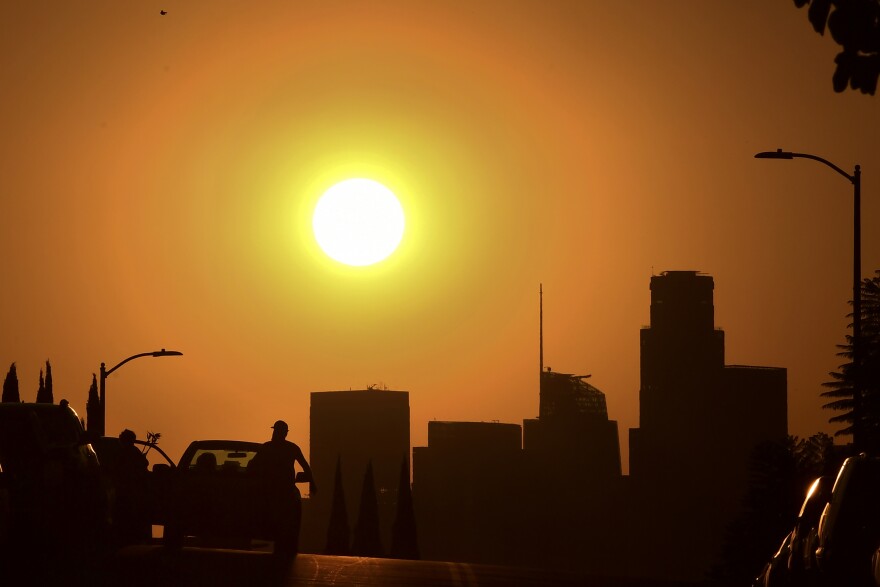Truth matters. Community matters. Your support makes both possible. LAist is one of the few places where news remains independent and free from political and corporate influence. Stand up for truth and for LAist. Make your year-end tax-deductible gift now.
More Than Half Of LA County Residents Will Be Severely Impacted By The Climate Crisis

The Los Angeles County Chief Sustainability Office published a report Wednesday that found 56% of county residents live in a neighborhood that is highly vulnerable to at least one major consequence of human-driven climate change: extreme heat, wildfire, drought, inland flooding or sea level rise.
Using census data, the county identified 47 communities that are particularly vulnerable, from Santa Clarita to Long Beach, from Crenshaw to East L.A.
One pattern was abundantly clear — the vast majority of census tracts most at risk to climate change are home to people of color, primarily Latino and Black communities.
”It highlights the climate hazards that we are all facing, all 10 million people who live in L.A., but it also does take the next step and says, ‘Who is most vulnerable?’” said Kristen Torres Pawling, Sustainability Programs Director in the Chief Sustainability Office and one of the key managers of the new research.
Discriminatory Policies
The reason that communities of color tend to be more vulnerable is no accident. Decades of racist and discriminatory policies pushed people of color to under-resourced parts of the county, areas with more industry, freeways and pollution as well as fewer parks and trees.
“Some communities like South Gate, don't necessarily have a built environment that's helping the people respond to climate change,” Pawling said. “So you might have more concrete in communities like South Gate than other more lush and well-shaded communities that have a better urban tree canopy cover. That is an example of the factors that go into the calculations for how we define climate vulnerability.”
Extreme heat is just one example of how climate change can exacerbate existing inequities. An essential piece of avoiding the worst impacts of climate change is addressing systemic racism, the report emphasizes. The issue is personal for Pawling — her family is from southeast L.A. She’s seen how detrimental it can be to have to walk too far to a bus stop during a heatwave or to live in housing that can’t keep the heat out.
Mapping The Data

Using census tract data, the latest climate projections, existing research and community input, the report aimed to show how those impacts may magnify if global greenhouse gas emissions continue rising at their current rate.
The Chief Sustainability Office, in partnership with community groups and other stakeholders, examined the census tracts of the county’s unincorporated areas and 88 cities through four lenses: present-day and projected changes in the climate, existing demographic trends (like race, age, and income), the state of the physical infrastructure, and finally, the ripple effect of climate impacts on the people who most rely on those infrastructure services.
They used the data to develop an interactive map so local governments can better understand the impacts they face and what steps they can take to protect residents who are bearing the brunt.
“We want to put our new map and some of these findings in the hands of local elected officials, planning staff, public works staff, so that they can have really detailed information around what types of infrastructure in their community are vulnerable and what populations in their communities are vulnerable. We are very much looking to be a partner for cities in the L.A. region as they prepare for the future,” Pawling said.
Listening Sessions
The data was bolstered by listening sessions with community members who are already experiencing the impacts of climate change in their neighborhoods. Climate Resolve, an L.A.-based non-profit, organized six listening sessions with about 66 stakeholders across the county to understand the nuanced challenges facing different communities.
”Part of it is telling a story that data doesn't tell,” said Natalie Hernandez, Associate Director of Climate Planning and Resilience for Climate Resolve.
“I think what the stakeholder engagement process did was also try to say, OK, there's the data, but then there's the stories. And out of the listening sessions, we were able to hear about, well, this is how it affects rural communities in northern L.A. County with regards to extreme heat and drought.”
Often Overlooked
The county and its partners also prioritized hearing from communities who face some of the most dangerous challenges during climate emergencies but are often overlooked: people who live in mobile homes, people who are unhoused, people with disabilities, people who work outside, people who have unreliable transportation, and Indigenous communities.
“Those populations were determined by the county and us and the project team as ones that we weren't seeing enough in the data, but we knew were experiencing the impacts,” Hernandez said.
Hernandez hopes the report can help spur investment in smaller cities with fewer resources. The report delves into other impacts as well, like inland flooding and extreme rainfall, wildfire and mudslides, coastal flooding and drought, that will all have cascading social and health impacts.
“These impacts are getting worse so we need to make investments now that consider where they can have the biggest bang for their buck and to do it soon,” Pawling said. “Because we know that it takes time for some of these interventions to really make a difference.”







